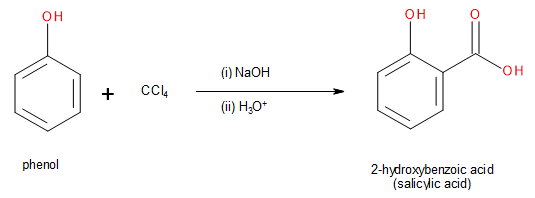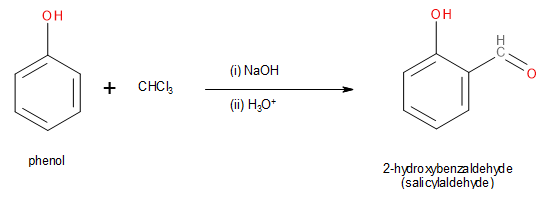
Salicylic acid can be prepared using Reimer - Tiemann’s reaction by treating phenol with:
A. Methyl chloride in the presence of anhydrous aluminium chloride
B. Carbon dioxide under pressure in sodium hydroxide solution
C. Carbon tetrachloride and concentrated sodium hydroxide
D. Sodium nitrite and a few drops of concentrated sulphuric acid
Answer
225k+ views
Hint: The Riemer-Tiemann reaction involves the ortho-formylation of phenol. In essence, it is a nucleophilic substitution reaction.
Complete Step by Step Solution:
The Riemer-Tiemann reaction is used for the ortho-formylation of phenols using a strong base in the presence of carbon tetrachloride (\[CC{l_4}\]). The strong base most commonly used is concentrated sodium hydroxide (\[NaOH\]) or potassium hydroxide (\[KOH\]).
While phenol is soluble in carbon tetrachloride, the hydroxide base is not. Therefore, this reaction is generally carried out in a solvent system that has two phases (biphasic). In its simplest case, the biphasic system consists of an aqueous phase containing the hydroxide base and an organic phase containing the carbon tetrachloride and phenol. The two phases are brought together (by rapid mixing or by using phase transfer catalysts) and heated to initiate the reaction. Although heating is required to start the reaction, once it is underway the reaction itself becomes highly exothermic.
The Riemer-Tiemann reaction of phenol with\[CC{l_4}\]and concentrated sodium hydroxide leads to the formation of salicylic acid as the product.

Image: Conversion of phenol into salicylic acid through Riemer-Tiemann reaction
Thus, the correct option is C.
Note: Although the reaction discussed above is termed as a Riemer-Tiemann reaction, it is a variation of it. The actual Reimer-Tiemann reaction consists of the reaction of phenol with chloroform (\[CHC{l_3}\]) and a strong hydroxide base to form salicylaldehyde as shown below.

Image: Riemer-Tiemann reaction of phenol.
Complete Step by Step Solution:
The Riemer-Tiemann reaction is used for the ortho-formylation of phenols using a strong base in the presence of carbon tetrachloride (\[CC{l_4}\]). The strong base most commonly used is concentrated sodium hydroxide (\[NaOH\]) or potassium hydroxide (\[KOH\]).
While phenol is soluble in carbon tetrachloride, the hydroxide base is not. Therefore, this reaction is generally carried out in a solvent system that has two phases (biphasic). In its simplest case, the biphasic system consists of an aqueous phase containing the hydroxide base and an organic phase containing the carbon tetrachloride and phenol. The two phases are brought together (by rapid mixing or by using phase transfer catalysts) and heated to initiate the reaction. Although heating is required to start the reaction, once it is underway the reaction itself becomes highly exothermic.
The Riemer-Tiemann reaction of phenol with\[CC{l_4}\]and concentrated sodium hydroxide leads to the formation of salicylic acid as the product.

Image: Conversion of phenol into salicylic acid through Riemer-Tiemann reaction
Thus, the correct option is C.
Note: Although the reaction discussed above is termed as a Riemer-Tiemann reaction, it is a variation of it. The actual Reimer-Tiemann reaction consists of the reaction of phenol with chloroform (\[CHC{l_3}\]) and a strong hydroxide base to form salicylaldehyde as shown below.

Image: Riemer-Tiemann reaction of phenol.
Recently Updated Pages
JEE Main 2025-26 Mock Test: Organic Compounds Containing Nitrogen

JEE Main 2025-26 Organic Compounds Containing Nitrogen Mock Test

JEE Main Chemical Kinetics Mock Test 2025-26: Free Practice Online

JEE Main 2025-26 Organic Compounds Containing Oxygen Mock Test

JEE Main 2025-26 Organic Compounds Containing Halogens Mock Test

Sodium acetate on heating with soda lime produce A class 12 chemistry JEE_Main

Trending doubts
JEE Main 2026: City Intimation Slip and Exam Dates Released, Application Form Closed, Syllabus & Eligibility

JEE Main 2026 Application Login: Direct Link, Registration, Form Fill, and Steps

Understanding the Angle of Deviation in a Prism

How to Convert a Galvanometer into an Ammeter or Voltmeter

Hybridisation in Chemistry – Concept, Types & Applications

Ideal and Non-Ideal Solutions Explained for Class 12 Chemistry

Other Pages
NCERT Solutions For Class 12 Chemistry Chapter 1 Solutions - 2025-26

JEE Advanced Marks vs Ranks 2025: Understanding Category-wise Qualifying Marks and Previous Year Cut-offs

Solutions Class 12 Chemistry Chapter 1 CBSE Notes - 2025-26

NCERT Solutions ForClass 12 Chemistry Chapter Chapter 4 The D and F Block Elements

Biomolecules Class 12 Chemistry Chapter 10 CBSE Notes - 2025-26

NCERT Solutions For Class 12 Chemistry Chapter 10 Biomolecules - 2025-26




